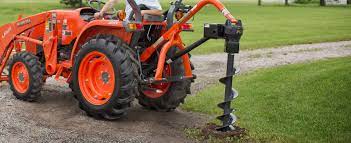An Kubota auger attachment is a power unit that is added to the three-point hitch of a tractor. It may also be referred to as a power draw bar or a post hole digger. The auger attachment uses its power to dig holes in the ground and position them conveniently as per the requirements.
The holes that are dug using an auger attachment are referred to as post holes. These post holes are used for digging tree planting holes, fence posts, landscaping decoration, composting holes and so on.
What does a kubota excavator auger attachment do?
Kubota excavator auger attachments are beneficial for many construction or landscaping projects. Kubota augers are designed to efficiently and safely bore holes into the ground, allowing you to dig out debris or plant trees without having to use a shovel. Kubota has many models of augers available, so you can choose the special features that best suit your needs
A kubota excavator auger attachment is made up of several parts. The shaft is the part that sticks out from the excavator, and this is where you will attach the bit, which digs into the soil. At the other end is a tip that attaches to the bucket. There are also drive motors and hydraulic lines, which power the machine’s movement Kubota excavator auger attachments come with several options for bits and shafts.
The type of bit you need depends on what kind of job you are doing and what kind of soil you are digging through. If you are only going through dirt, for example, you can use a standard bit. Those who need to break through rocks or concrete may need something more durable like a carbide-tipped bit The shape of the shaft determines how far it can reach and what position it is in when digging.

How does an auger bucket for a kubota excavator work?
We’re getting a lot of questions about the auger bucket for Kubota excavators, so we thought we’d put together some info to help you understand how it all works.
The auger bucket for Kubota excavator is a type of excavation equipment that is used in construction projects. It is also referred to as a power shovel or digger. The name comes from the Greek word “auger,” which means “to dig.” The bucket is mounted on wheels, which allows it to move around and dig holes in the ground. The bucket can be used to remove dirt and rocks from the ground, so they can be transported away through pipes or other means.
There are many different types of auger buckets available, but they all have one thing in common: They are designed with an auger at their center, which rotates to create holes in the ground. These buckets are typically made out of metal (usually steel), although some models may also use plastic. They come in different sizes and shapes, depending on what you need them for; however, most of them have an open top and bottom that allow water or mud to flow through them easily.
What is the difference between an excavator auger and an excavator post-hole digger?
The auger attachment is a drilling tool for excavators. It is designed to drill holes in the soil in order to bury poles and posts.
How does it work? Auger attachments consists of two parts: one that goes on the excavator arm, and the other part, which is a rotating tool (auger) that is attached to the excavator arm by means of a hydraulic motor. The auger is powered by the hydraulic motor, which causes it to turn while drilling into the soil. When should I use an auger attachment? An auger attachment is used when you need to drill holes in order to bury poles or posts. It can also be used as a hole digger. What are its advantages?
An auger attachment is an efficient tool for drilling holes in soil. The tool can be adjusted according to the length of the post or pole you want to bury. How can I make sure that my Kubota Excavator Auger Attachment works properly? You have to make sure that your excavator has all the necessary attachments in order for your excavator auger attachment to work properly.
What size kubota is an auger attachment for?
Kubota auger attachment is a tool that can be used to bore holes in the ground. They are commonly used for agricultural and construction applications, but have significant utility in other industries as well. An auger attachment comes in various sizes and shapes, depending on its intended use.
Augers have a rotating helical screw blade called a “flighting” to act as a screw conveyor to remove the drilled out material. The rotation of the blade causes the material to move out of the hole being drilled. There are different kinds of augers such as earth augers, hand augers, and ice augers, each with its own unique purpose. The most common use for an auger is to dig post holes for fences or other construction projects.
They can also be used to dig holes for trees and shrubs, as well as other gardening tasks. They are also useful for digging trenches to lay pipes. Augers come in several sizes and models depending on their intended use. The size of an auger determines how deep it will go into the ground before it encounters resistance from rocks or tree roots. The depth of penetration is important because it determines the amount of force required to operate the equipment.
How much does an excavator auger cost?
An auger is a drill attachment used to dig holes in the ground. It is most commonly used in the farming industry, but it also has many uses in the construction industry. Augers are powered by hydraulic motors, which makes them ideal for heavy digging jobs.
An excavator auger is mounted on an excavator bucket and works by rotating as it digs into the ground. It can dig up to 12 inches deep and is often used to plant trees or build fences. Augers have many attachments that make them versatile tools for digging holes in the ground. They can be fitted with cutting heads of different sizes and shapes for specific tasks such as planting trees or building fences.
The most common type of auger attachment is the earth auger, which has a round head that rotates counterclockwise to bore through soil at an angle of up to 90 degrees from vertical. The cost of an excavator auger depends on several factors, including its size and whether it comes with attachments like blades or teeth for digging through rocky terrain or clay soils.
An excavator post-hole digger is one of the most versatile attachments and can be used for multiple projects.
A Kubota excavator auger attachment is a must-have for any construction crew. With a Kubota auger attachment, you can use your excavator for multiple tasks — such as digging holes for fence posts, poles and signs, as well as drilling and hole boring.
The hydraulic motor drives the rotational motion and allows the auger to work in forward and reverse. It also gives you the ability to turn at high RPMs to complete the toughest jobs in minimal time. The hydraulic pressure is adjustable so you can add more force when needed. All of these features allow you to keep working without stopping, saving you time and money. An excavator post-hole digger is one of the most versatile attachments and can be used for multiple projects.
You can use it for anything from building decks and yard projects to irrigation systems, sign and light installation, fence posts and more. With this attachment, all of your post-hole digging needs are met with one simple tool. You want to make sure you have the best post-hole digger auger on the market today. Look for brands that offer a wide range of sizes from 4 inches up to 36 inches or more so that you can tackle any job with ease, regardless of size or depth.
Summary:
In the end, there are a number of attachments that can be added to the Kubota RTV1100. While not all of them are specifically made for blading and any given attachment may require some basic mechanical skills, they can greatly expand the functionality of this machine. A rear blade is a fairly common attachment that can be utilized before as well as after finishing with the other attachments.
It allows operators to lay down a straight cut instead of having to deal with the curvature in a plot of land. This means a process that would take more time and possibly multiple passes with an individual attachment is moved into one easy step.
